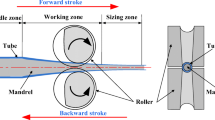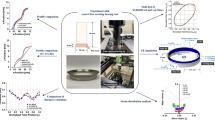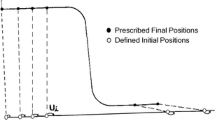Abstract
In this research, a novel plasto-dynamic analytical and numerical modeling is developed for tube expansion during a high-strain rate forming process, such as electromagnetic and liquid shock tube forming. The analytical model is based on applying the impact mechanic and shell theories with introducing an effective load along with imposing high-order non-linearity of material behavior. The numerical model is also conducted by dynamic explicit finite element setup with considering an equivalent transient and traveling load. Both analytical and numerical models are compared with each other and validated with experimental measurements of different processes available in literature. The analytical model has satisfactorily acceptable prediction, especially for small strains, locations far from dies or supports, and for processes with high load-to-material resistance ratio and with less complicated interaction and loading nature. The numerical modeling is also effective if precise data input is provided. Several parameter studies are carried out, and conditions for achieving a high-performance forming process are discussed. The magnitude of total impulse and inertia force have significant roles, but traveling speed and profile shape of load have no considerable effects on plastic deformation. For AISI 316L, strain hardening and thermal softening have major and minor influences on material strength, respectively.















Similar content being viewed by others
References
Blazynski TZ (2012) Explosive welding, forming and compaction. Springer Science & Business Media
Mynors DJ, Zhang B (2002) Applications and capabilities of explosive forming. J Mater Process Technol 125:1–25
Motoasca TE (2003) Electrodynamics in deformable solids for electromagnetic forming. PHD thesis. Universitatea Transilvania din Brasov
Kleiner M, Hermes M, Weber M, Olivier H, Gershteyn G, Bach FW, Brosius A (2007) Tube expansion by gas detonation. Prod Eng 1(1):9–17
Psyk V, Gerstein G, Barlage B, Albuja B, Gies S, Tekkaya AE, Bach FW (2012) Process model and design for magnetic pulse welding by tube expansion. ICHSF 2012:197
Jeanson AC, Bay F, Jacques N, Avrillaud G, Arrigoni M, Mazars G (2016) A coupled experimental/numerical approach for the characterization of material behaviour at high strain-rate using electromagnetic tube expansion testing. Int J Impact Eng 98:75–87
Yu H, Sun L, Zhang X, Wang S, Li C (2016) Experiments on electrohydraulic forming and electromagnetic forming of aluminum tube. Int J Adv Manuf Technol 89(9–12):3169–3176
Woo MA, Noh HG, Song WJ, Kang BS, Kim J (2017) Experimental validation of numerical modeling of electrohydraulic forming using an al 5052-H34 sheet. Int J Adv Manuf Technol 93(5–8):1819–1828
Li S, Cui X, Feng H, Wang G (2017) An electromagnetic forming analysis modelling using nodal integration axisymmetric thin shell. J Mater Process Technol 244:62–72
Zheng Q, Yu H, Deng J (2018) Numerical simulation of electrohydraulic forming of aluminium alloy tubes. ICHSF 2018. The Ohio State University
Qiu L, Yu Y, Xiong Q, Deng C, Cao Q, Han X, Li L (2018) Analysis of electromagnetic force and deformation behavior in electromagnetic tube expansion with concave coil based on finite element method. IEEE Trans Appl Supercond 28(3):1–5
Ma H, Huang L, Li J, Duan X, Ma F (2018) Effects of process parameters on electromagnetic sheet free forming of aluminum alloy. Int J Adv Manuf Technol 96(1–4):359–369
Yua H, Chenc J, Liud W, Yin H, Li C (2018) Electromagnetic forming of aluminum circular tubes into square tubes: experiment and numerical simulation. J Manuf Process 31:613–623
Cui X, Yu H, Wang Q (2018) Electromagnetic impulse calibration in V-shaped parts. Int J Adv Manuf Technol 97(5–8):2959–2968
Su H, Hung L, Li J, Ma F, Hung P, Feng F (2018) Two-step electromagnetic forming: a new forming approach to local features of large-size sheet metal parts. Int J Mach Tools Manuf 124:99–116
Qiu L, Yu Y, Yang Y, Nie X, Xiao Y, Ning Y, Wang F, Cao C (2018) Analysis of electromagnetic force and experiments in electromagnetic forming with local loading. Int J Appl Electrom Mech 57(1):29–37
Beltman WM, Shepherd JE (1998) Structural response of shells to shock and detonation loading. In: Parts I and II, technical report FM98-3. California Institute of Technology, Pasadena, CA April, 1998
Beltman WM, Shepherd JE (2002) Linear elastic response of tubes to internal detonation loading. J Sound Vib 252(4):617–656
Kosing OE, Skews BW (1998) An investigation of high-speed forming of circular plates in a liquid shock tube. Int J Impact Eng 21(9):801–816
Skews BW, Kosing OE, Hattingh RJ (2004) Use of a liquid shock tube as a device for the study of material deformation under impulsive loading conditions. Proc Inst Mech Eng C J Mech Eng Sci 218(1):39–51
Hasebe T, Takenaga Y, Kakimoto H, Imaida Y (1999) High strain rate forming using an underwater shock wave focusing technique. J Mater Process Technol 85(1–3):194–197
Jones N (2011) Structural impact. Cambridge University Press
Martineau R L (1998) A visco-plastic model of expanding cylindrical shells subjected to internal explosive detonations (Doctoral dissertation, Colorado State University)
Esquivel EV (2005) Fundamental microstructural issues associated with severe plastic deformation: applications of transmission electron microscopy. PHD thesis. University of Texas at EL Paso
Johnson G R, Cook W H (1983) A constitutive model and data for materials subjected to large strains, high strain rates, and high temperatures. Proc 7th Inf Sympo Ballistics, 541–547
Kumar R, Kore S D (2016) Pulse electromagnetic cladding of Al-tube on DP steel rod. Proceedings of 6th International & 27th All India Manufacturing Technology, Design and Research Conference (AIMTDR-2016), College of Engineering, Pune, Maharashtra, India, December, 611–615
Umbrello D, M’saoubi R, Outeiro JC (2007) The influence of Johnson–Cook material constants on finite element simulation of machining of AISI 316L steel. Int J Mach Tools Manuf 47(3–4):462–470
Author information
Authors and Affiliations
Corresponding author
Additional information
Publisher’s note
Springer Nature remains neutral with regard to jurisdictional claims in published maps and institutional affiliations.
Rights and permissions
About this article
Cite this article
Ghadami, S., Dariani, B.M. Analytical and numerical modeling of high-strain rate metal-tube forming. Int J Adv Manuf Technol 103, 4147–4160 (2019). https://doi.org/10.1007/s00170-019-03840-w
Received:
Accepted:
Published:
Issue Date:
DOI: https://doi.org/10.1007/s00170-019-03840-w




